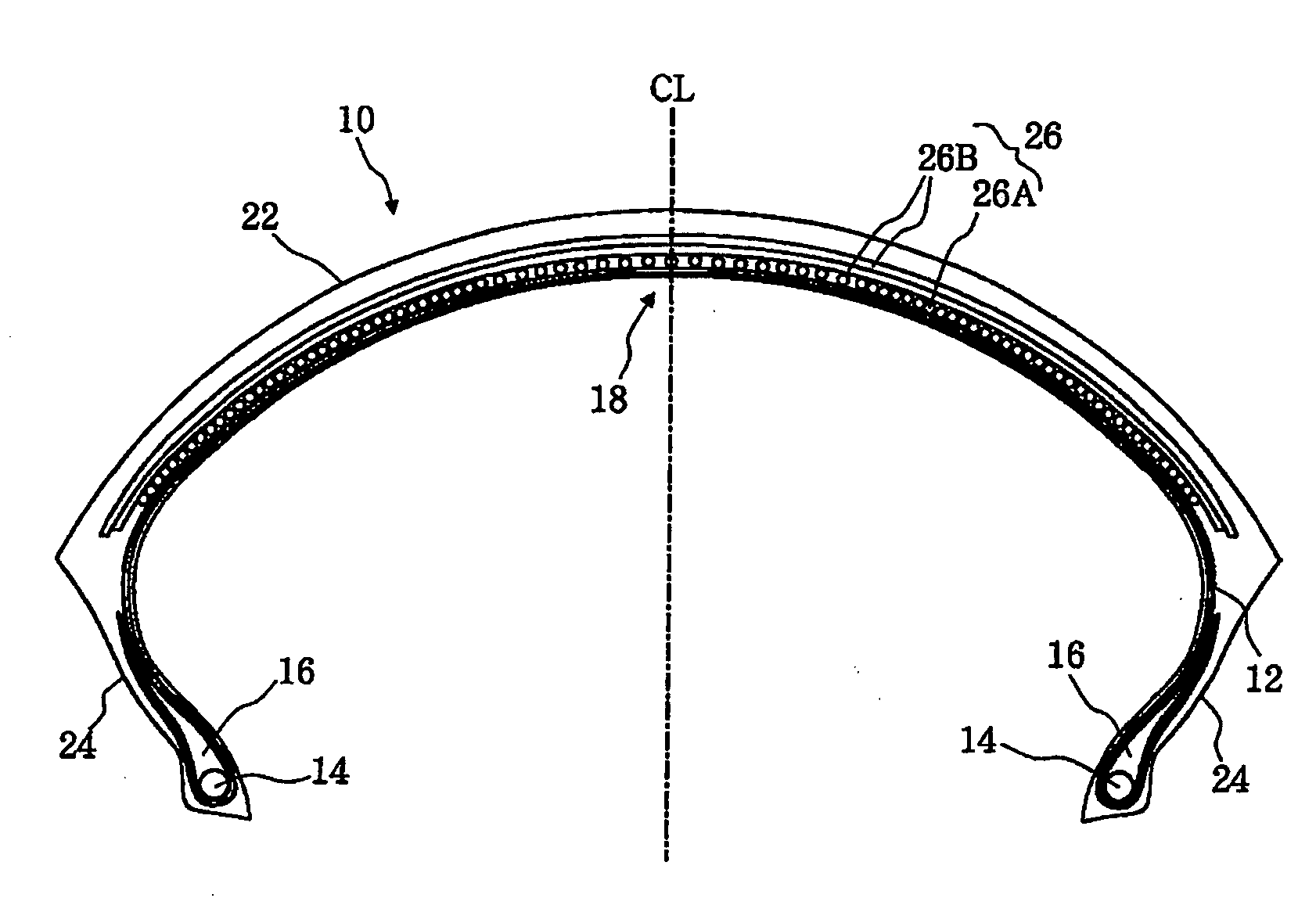Pneumatic tire for two-wheeled motor vehicle
- Summary
- Abstract
- Description
- Claims
- Application Information
AI Technical Summary
Benefits of technology
Problems solved by technology
Method used
Image
Examples
example 1
[0090] The pneumatic tire 10 for a two-wheeled motor vehicle according to the embodiment shown in FIG. 1 was used as a rear tire. This tire has a size of 190 / 50ZR17, and is provided with two nylon carcass plies and bead fillers having a hardness of 95° (Shore A hardness).
[0091] The spiral belt 26A was formed by spirally winding one long length of rubber-coated cord made of aramid fibers (Kevlar™ made by du Pont Corp.; twisted structure: 1670d / 2; initial tensile resistance: 736 cN / cord) obtained by coating the cord with rubber. The driving count was 30 cords / 25 mm.
[0092] On the other hand, the two angled belt 26B provided on the out layer of the spiral belt 26A are belt plies (driving count: 18 cords / 25 mm) of cords made of aramid fibers (Kevlar™ made by du Pont Corp.; twisted structure: 1670d / 2; initial tensile resistance: 736 cN / cord). The cord angle thereof is 45° with respect to the equatorial plane of the tire. The two angled belts 26B cross each other, and simultaneously, til...
example 2
CONVENTIONAL EXAMPLE 2
[0096] The same rear tire as that used in the example was employed as a sample tire, with the exception that the type shown in FIG. 13 was used for a pattern on the tread surface portion in the tread 22. In the tread pattern shown in FIG. 13, the main groove component M1 in FIG. 4 does not exist, and tilting main grooves S4, which form truncated chevron shapes as viewed from the rear side of the rotational direction of the tire, extend beyond the tread center portion alternately on the right and left sides, and opposing ends of the tilting main grooves S4 mutually couple in an alternating manner, thereby forming chevron shapes. The area ratio of all grooves in a pattern on the tread surface portion is substantially the same as that in the example 1.
[0097] With each of these tires mounted to a vehicle as a respective one of the rear tires, a conventional tire having a size of 120 / 70ZR17 was mounted as a front tire in each case, and running tests were performed....
example 3
CONVENTIONAL EXAMPLE 3
[0116] The same front tire as that used in the example 3 was used as a sample tire, with the exception that the type shown in FIG. 14 was used for a pattern on the tread surface portion in the tread 22. In the tread pattern shown in FIG. 14, a main groove component C4 exists, and there are provided tilting main grooves S5, which form truncated chevron shapes as viewed from the rear side of the rotational direction of the tire. The area ratio of all grooves in a pattern on the tread surface portion is substantially the same as that in the example 3.
CONVENTIONAL EXAMPLE 4
[0117] The same front tire as that used in the example 3 was used as a sample tire, with the exception that the type shown in FIG. 15 was used for a pattern on the tread surface portion in the tread 22. In the tread pattern shown in FIG. 15, a main groove component C5 exists, and there are provided tilting main grooves S6, which form inverted truncated chevron shapes as viewed from the rear sid...
PUM
 Login to View More
Login to View More Abstract
Description
Claims
Application Information
 Login to View More
Login to View More - R&D
- Intellectual Property
- Life Sciences
- Materials
- Tech Scout
- Unparalleled Data Quality
- Higher Quality Content
- 60% Fewer Hallucinations
Browse by: Latest US Patents, China's latest patents, Technical Efficacy Thesaurus, Application Domain, Technology Topic, Popular Technical Reports.
© 2025 PatSnap. All rights reserved.Legal|Privacy policy|Modern Slavery Act Transparency Statement|Sitemap|About US| Contact US: help@patsnap.com



